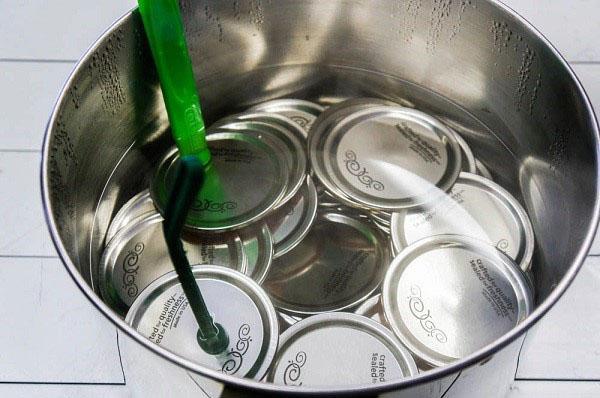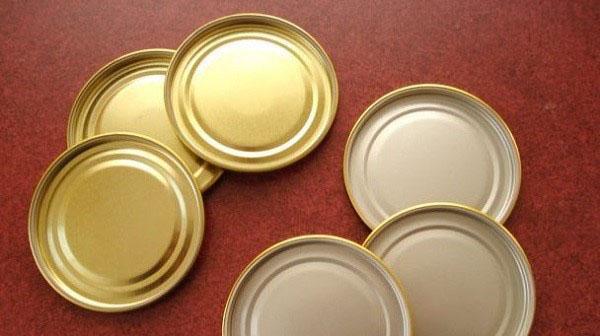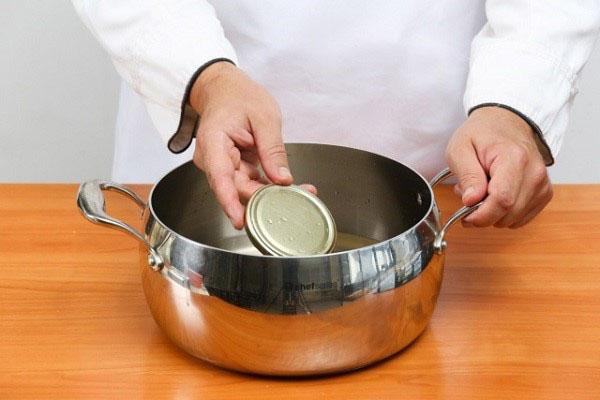Sterilization of lids for seaming in boiling water, microwave or steam
 The conservation process is quite laborious and requires careful preparation, so every housewife should know the main points. Let's start with the preparation, namely how to sterilize the seaming lids, heat treatment of glass jars, what is it for and how each stage takes place. We will look at the basic methods of sterilizing canning ingredients.
The conservation process is quite laborious and requires careful preparation, so every housewife should know the main points. Let's start with the preparation, namely how to sterilize the seaming lids, heat treatment of glass jars, what is it for and how each stage takes place. We will look at the basic methods of sterilizing canning ingredients.
Preparation for sterilization

Do not forget about the tongs, because when boiling, high temperature is used and you cannot take a jar or a lid with your bare hands!
Sterilization in simple words is a heat treatment that disinfects and cleans the surface of lids and cans from microorganisms. The need for the process is to exclude the possibility of fermentation, which can lead to spoilage of the preserved product. With cans, everything is simple - they need to be checked for chips and cracks, and then thoroughly washed. As for the covers, you should be careful here, the products must have the correct, that is, even shape without damage and bends.
 "Do I need to sterilize the seaming caps?" - this question is often asked by many housewives. If you have a similar thought, that's good, and here's the answer - this is a mandatory norm. Remember that the result depends on the correct preparation. The purpose of this article is to help you achieve maximum conservation quality.
"Do I need to sterilize the seaming caps?" - this question is often asked by many housewives. If you have a similar thought, that's good, and here's the answer - this is a mandatory norm. Remember that the result depends on the correct preparation. The purpose of this article is to help you achieve maximum conservation quality.
If rust or dirt is visible on the covers, the paintwork on the inside is defective, or the surface is damaged by bending, then such a component must not be used for conservation!
How to sterilize seaming caps?
 One of the simplest ways we can highlight thermal cleaning in a double boiler. Here you can sterilize both cans and preservation lids at the same time. To do this, you must thoroughly wash the cans and place them in the device. In cooking mode, set the time to 15-20 minutes. At the same time, you can put lids there at once, the main thing is not to cover the neck of the cans, so that the heat treatment process takes place inside the glass tank.
One of the simplest ways we can highlight thermal cleaning in a double boiler. Here you can sterilize both cans and preservation lids at the same time. To do this, you must thoroughly wash the cans and place them in the device. In cooking mode, set the time to 15-20 minutes. At the same time, you can put lids there at once, the main thing is not to cover the neck of the cans, so that the heat treatment process takes place inside the glass tank.
Features of the method:
- simple, fast, saves you energy;
- there will be no heat in the kitchen;
- suitable only for those who have a steamer;
- a device with a large volume is required to sterilize several cans at the same time.
We recommend sterilization of cans and lids synchronously, that is, simultaneously, since sudden temperature changes can affect the result. Agree, it will be extremely unpleasant if the hot neck of the jar cracks because of the cold lid. The uniform temperature of the preservation components guarantees a safe seaming without any risk of damage.
How to sterilize rubber seaming caps?
One option is steam sterilization, which is ideal for rubber sealed lids. Here it is worth remembering that the rubber part must receive a sufficient amount of steam, therefore, the lid must be installed so that the steam gets exactly on the underside of the lid.
There is a point that should also be remembered - you should not remove the gum from the lid when it is being heat treated.The thing is that it will be difficult to insert the rubber part in a heated state, despite the fact that the lid itself will also heat up.
How to sterilize the seaming screw caps?
 Undoubtedly, sterilization alone is not enough, and even if the lid is twisted rather than rolled with a key, heat treatment is also necessary here. Microbes should not get into the container with conservation, so do not forget about sterilizing the screw caps.
Undoubtedly, sterilization alone is not enough, and even if the lid is twisted rather than rolled with a key, heat treatment is also necessary here. Microbes should not get into the container with conservation, so do not forget about sterilizing the screw caps.
A sure and reliable way is to boil in hot water. The action is carried out immediately before the cover is rolled up. It is worth remembering how many minutes to boil the lids for seaming, as a rule - from 10 to 15 minutes will be quite enough.
It is not recommended to sterilize the seaming lids in the dishwasher or microwave oven!
In general, the process of heat treatment of cans and lids for conservation is required. By sterilization, you guarantee the quality of the result - no contamination, turbidity, swollen lids due to fermentation.
The methods are different but give the same result. If it is steam, then pay attention to the position of the jar or lid, perform all manipulations with hot objects using special tongs, in the case of heating in water - remember how much to boil the lids for seaming. Sterilization is a mandatory process, but individual. Sometimes pasteurization of cans and lids can be combined, and in some cases it is simply unacceptable.